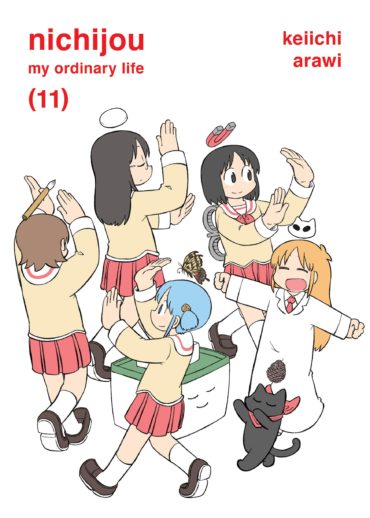Nichijou Volume 11 Review
The ironically named Nichijou (My Ordinary Life) is a series which has certainly grown in reputation over the years.
For some critics, the lack of any real plot involving the surreal adventures of the characters was off-putting, but over time people came to appreciate Keiichi Arawi’s work for what it is: a series of silly adventures. If you were to compare it to a Western style of comedy, it is more like a sketch show than a sitcom. Given the fact that all the sketches take place in the same town, perhaps it is most akin to something like The League Of Gentlemen, but without all the horror.
This eleventh volume is the first tankobon release of Nichijou in six years. Given this, it is probably best for even experienced readers of the series to go back to previous volumes to re-familiarise themselves with the characters and setting. The story follows the locals of the fictional town of Tokisadame, and mostly concerns the exploits of schoolgirls Yuuko (the lazy, brown-haired girl), Mio (the artistic blue-haired girl), Mai (the quiet, clever girl in the glasses), and Nano (the robot girl with a giant clockwork key stuck in her back, who was created by an eight-year-old Professor who also gave a cat the ability to talk).
Once again, the series delivers a series of unrelated adventures involving them, their school friends and their teachers. In this edition, Mio becomes hysterical when a caterpillar lands on her back and Yuuko keeps putting off helping her. Teacher Mr. Takasaki comes to the rescue with a stick of rice-filled bamboo when the Vice-Principle wants to shut down the school’s Go/Soccer Club, while Takasaki also ends up breaking the bank to buy a ¥200,000 ham to impress his love and work colleague Ms. Sakurai and the Professor would rather stay inside a tooled-up floating box than clean the house.
The fellow students of the main gang also have their own escapades, with the aristocratic goat-riding Sasahara unfazed when he is being chased by a jaguar, while the ribbon-wearing Annaka is sent to Hell after being killed by a beetle.
As mentioned, it is probably best to look back over some previous editions of Nichijou to get familiar with its style once more, but this new book still has some funny moments. My personal favourite was the story of Sasahara and the jaguar, mainly because of the ultimate reveal which I shall not give away, but certainly made me laugh. In terms of production, nothing seems to be problematic with the translation by Jenny McKeon. While no credit is given to whoever did the lettering in this edition, it is also good, especially in the opening story concerning Mio and the caterpillar, as she becomes increasingly frantic and manic, with text matching her increasingly panic.
While it may take some getting used to once again following the six-year absence, it is nice to see that Nichijou is still able to produce some funny, unexpected laughs. It was worth waiting for to see the old gang again.
Our review copy from Kodansha was supplied by Turnaround Comics (Turnaround Publisher Services).


